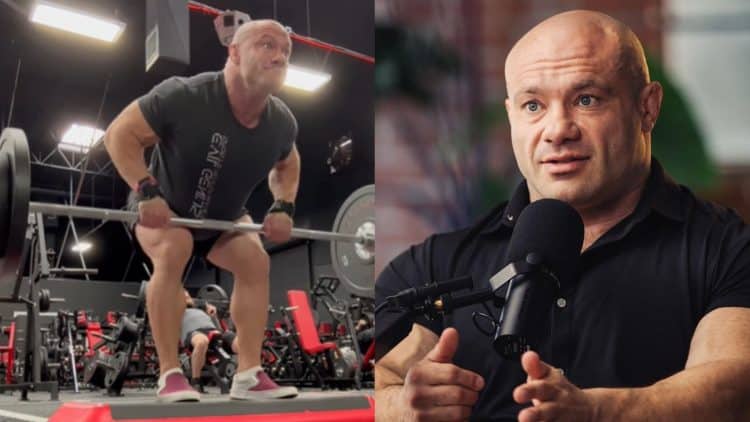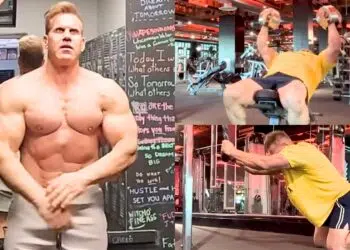Exercise scientist Dr. Mike Israetel, a revered nutritionist, lights up with glee anytime he has the opportunity to discuss training and muscle-building. In his latest appearance on Chris Williamson’s YouTube channel, Israetel broke down his four-factor model checklist for ideal rest periods and opened up on how to properly warm up.
With a Ph.D. in sports physiology under his belt, Israetel stands out among his peers thanks to his deep understanding of fitness, health, and nutrition. Having once served as a professor in the exercise and sports sciences at Temple University’s School of Public Health in Philadelphia, his expertise in muscle growth is not only groundbreaking but highly sought after for those seeking hypertrophy.
Having shared the microphone with other notable fitness minds such as natural bodybuilder/powerlifter Jeff Nippard, Israetel’s witty yet easy-to-understand content has turned him into a source of knowledge for anyone after a better body. While often neglected by lifters inside the gym, Israetel used his latest interview to elaborate on the importance of proper rest periods and warm-ups.
Dr. Mike Israetel Discusses The Proper Way to Warm Up for Training
Israetel provided insight into two different warm-up scenarios, the first being a general warm-up which typically involves practices such as the elliptical, foam rolling, or dynamic stretching.
Level Up Your Fitness: Join our 💪 strong community in Fitness Volt Newsletter. Get daily inspiration, expert-backed workouts, nutrition tips, the latest in strength sports, and the support you need to reach your goals. Subscribe for free!
“Warm-up music aside, there is actually a study that was recently conducted by Dr. Brad Schoenfeld, the world’s expert on hypertrophy and his laboratory. And they have illustrated something that most lifters of a certain degree of intelligence level and long-time participation have realized and it’s that there are two different kinds of warm-up.”
“The general warm-up, which is when you go in and do the elliptical for 15 minutes, maybe you foam roll, maybe you do some dynamic stretching, that’s all fine and good. And then there’s the specific warm-up which is whatever lift you have first in your program, you do it for about a set of 12, very light weights, a set of 12 with maybe your 30-rep max.
In addition, the sports physiologist underlined the importance of a specific warm-up which starts with lighter weights and reps before attempting a more challenging set.
“Then, you do a set of eight after a few minutes of rest with maybe your 20-rep max. Then, you do a set of four-ish two to four reps with something like your 10-rep max. Then, you rest a little bit and then you’re ready to do whatever load. That specific warm-up is a very good idea from a variety of perspectives,” explains Dr. Mike Isaetel.
The specific warm-up is key to avoiding injuries, according to Israetel.
“It warms up your tissue, makes them more pliable, less likely to get hurt. It also activates and wakes up your nervous system. It aligns your actual muscle fibers more to the direction of pull or whatever exercise you’re doing.”
Using science to explain his answer, Israetel pointed to a sensitivity decrease in the Golgi Tendon Organs, detectors in the muscles that interpret how much electrical force is needed to complete the movement or task at hand.
“It decreases the sensitivity of what are called Golgi Tendon Organs which are detectors in your muscles for how much force is being transduced and they start out not warmed up by being like holy shit that’s a lot of force and they actually tamper down how much your nervous system can activate. After a few warm-up sets, you literally are stronger.”
“I would be careful on wasting too much time on a general warm-up. One of the things that happens in fitness there’s really good stuff baked into the fitness cake and every now and again we add ingredients just on fluff alone. They don’t make a whole lot of sense. One of the major kind of sources of fluff is increasing the complexity and duration of your general warm-up.”
Exercise Scientist Israetel’s ‘Four-Factor’ Checklist for Rest Periods
Mike Israetel also revealed his four-tiered checklist for ideal rest periods in between sets.
Quick Breakdown
- Cardiovascular system properly recovered
- Neural strength returned
- Synergists are no longer a limiting factor
- Target muscle’s capacity for recovery
Even though there isn’t a one-size-fits-all solution, Israetel highlighted the need for a 2-5 minute rest period, though explains that it won’t always be necessary, depending on the specific exercise being used.
“No, wait that’s not it. A lot of answers you’ll get on the internet from folks that also know what they are talking about. It is some number of minutes. I understand that answer because it’s a very useable. Let’s say 2-5 minutes of something like that, the problem is that it’s not a theoretically based answer, it’s just a notional answer, like here’s the number.”
“There are many exceptions. For example, if you train your calves and calf raises, are you telling me I need to rest five fucking minutes after my calves, ten seconds after I don’t even feel lactic acid anymore. I’m fucking totally good to go.”
To provide additional insight, Israetel explained the four factors below that make up an ideal rest period.
“Number one, the cardiovascular system needs to be mostly recovered. Number two, you need to have your neural strength back, you need to be like yeah, fuck let’s do this. Second to last one is the synergists need to no longer be a limiting factor.”
“The last fourth-factor model checklist is does the target muscle have enough recovery in it for it to be able to do it at least another five repetitions. Because any set less than five reps can be hypertrophic for sure, but not the most efficient use of your time.”
Mike Israetel has a history of deep-diving into exercise mechanics and science. In his last offering to fans, Israetel revealed which 10 exercises he would use for a lifetime to achieve muscle growth. This list came following many others, including reigning five-time Classic Physique Olympia Chris Bumstead’s and Open class star Nick Walker’s.
From exercise selection, intensity, reps, and sets, to rest periods and warm-ups, Mike Israetel has left no rocks unturned on his quest to offer his audience free and actionable advice for pushing the boundaries inside the training room.
RELATED: Exercise Scientist Reveals Strategy for Developing Unstoppable Gym Motivation









